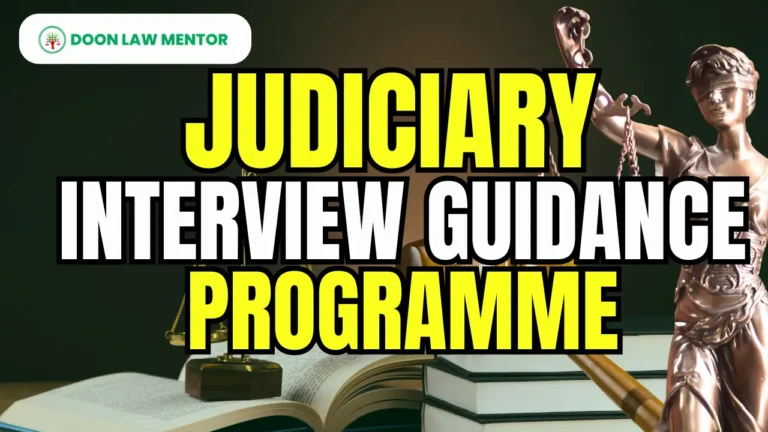The Supreme Court’s landmark decision in Amit Kumar & Ors. versus Union of India & Ors. (2025 SC) addresses the mental health crisis in colleges by forming the National Task Force Against Student Suicides. Led by Justice S. Ravindra Bhat, this task force aims to tackle issues like ragging, caste discrimination, and academic pressure. Learn how this initiative can transform student welfare in higher education.
Table of Contents
Introduction
The alarming rise in student suicides in higher educational institutions (HEIs) has become a pressing public health and social justice issue in India, drawing the attention of the Supreme Court. On March 24, 2025, the apex court took a groundbreaking step by constituting the National Task Force Against Student Suicides in the case of Amit Kumar & Ors. versus Union of India & Ors. (2025 SC). This decision, delivered by Justices JB Pardiwala and R Mahadevan, aims to address the mental health crisis in colleges and prevent further tragedies by tackling root causes such as caste discrimination, ragging, academic pressure, and other forms of institutional harassment.
The Supreme Court emphasized that universities are not merely centers of academic learning but also spaces responsible for the holistic well-being of students. The formation of the National Task Force Against Student Suicides marks a significant step toward creating a safer and more inclusive academic environment. This blog provides an in-depth exploration of the Supreme Court’s directive, the composition and mandate of the National Task Force Against Student Suicides, its potential to reshape student welfare, and its relevance for Judiciary, APO, and JLO aspirants preparing for 2025 exams.
Background of the Case: A Tragic Catalyst
The Supreme Court’s decision to form the National Task Force Against Student Suicides was triggered by a heart-wrenching petition filed by the parents of two IIT Delhi students, Ayush Ashna and Anil Kumar, who allegedly died by suicide in 2023. The petitioners, belonging to the Scheduled Caste community, claimed their children faced relentless caste-based discrimination and academic pressure at the institute. Despite repeated complaints to the authorities, the Delhi Police failed to register an FIR, leaving the families with no choice but to seek justice through the Supreme Court.
The Court noted a disturbing pattern of student suicides across HEIs, including prestigious institutions like the Indian Institutes of Technology (IITs), National Institutes of Technology (NITs), and Indian Institutes of Management (IIMs). These incidents often stem from systemic issues such as institutional neglect, discrimination, and a lack of mental health support. The Supreme Court’s ruling highlighted the urgent need for a comprehensive mechanism to address these issues, leading to the establishment of the National Task Force Against Student Suicides. For more insights into the legal implications of this case.
The Supreme Court’s Directive: A Two-Pronged Approach
In its March 24, 2025, ruling, the Supreme Court issued two critical directives to address the mental health crisis in colleges. First, it mandated that institutions must promptly lodge an FIR in the event of a student suicide on campus, calling it their “unequivocal duty.” This ensures legal accountability and transparency in investigating such incidents, addressing the petitioners’ grievance about the Delhi Police’s inaction.
Second, the Court established the National Task Force Against Student Suicides to tackle the root causes of student suicides and develop a national action plan for mental health services in HEIs. The Court observed, “The recurring instances of student suicides in Higher Educational Institutions, including private educational institutions, serve as a grim reminder of the inadequacy and ineffectiveness of the existing legal and institutional framework.” This directive underscores the need for a proactive approach to student welfare, ensuring that every student feels safe, supported, and empowered. For a deeper understanding of the Supreme Court’s role in social justice,.
Composition of the National Task Force Against Student Suicides
The National Task Force Against Student Suicides is a 10-member panel designed to bring diverse expertise to address the mental health crisis in colleges. Chaired by Former Supreme Court Judge Justice S. Ravindra Bhat, the task force includes:
- Dr. Alok Sarin, Consultant Psychiatrist at Sitaram Bhartia Institute, New Delhi, bringing expertise in mental health.
- Prof. Mary E. John, Former Director at the Centre for Women’s Development Studies, focusing on gender-based discrimination.
- Mr. Arman Ali, Executive Director of the National Centre for Promotion of Employment for Disabled People, addressing disability rights.
- Prof. Rajendar Kachroo, Founder of Aman Satya Kachroo Trust, known for his work on anti-ragging initiatives.
- Dr. Aqsa Shaikh, Professor at Hamdard Institute of Medical Sciences, contributing insights on community medicine.
- Dr. Seema Mehrotra, Professor of Clinical Psychology at NIMHANS, offering psychological expertise.
- Prof. Virginius Xaxa, Visiting Professor at the Institute for Human Development, focusing on tribal identity issues.
- Dr. Nidhi S. Sabharwal, Associate Professor at the National University of Educational Planning and Administration, for policy research.
- Ms. Aparna Bhat, Senior Advocate and amicus curiae, providing legal guidance.
This diverse composition ensures a multidisciplinary approach, covering mental health, social justice, education policy, and legal perspectives, making the National Task Force Against Student Suicides well-equipped to tackle the complex issues at hand. To learn more about mental health initiatives in education, explore NIMHANS’s resources on mental health.
Mandate of the National Task Force Against Student Suicides
The Supreme Court outlined a comprehensive mandate for the National Task Force Against Student Suicides, aiming to address the root causes of student suicides and propose systemic solutions. The key objectives include:
- Identify Causes: Investigate factors such as ragging, caste-based discrimination, gender-based discrimination, sexual harassment, academic pressure, financial stress, and discrimination based on tribal identity, sexual orientation, or political views.
- Review Policies: Assess existing student welfare and mental health policies in HEIs to identify gaps and inefficiencies.
- Recommend Legal Reforms: Suggest amendments to strengthen protections under the SC/ST (Prevention of Atrocities) Act, 1989, and other relevant laws addressing discrimination.
- Conduct Surprise Inspections: Visit universities to evaluate student support mechanisms, ensuring compliance with mental health standards.
- Develop a National Action Plan: Create a framework for the mandatory inclusion of mental health services in all HEIs, ensuring accessibility for all students.
The National Task Force Against Student Suicides is also empowered to make additional recommendations beyond its specified mandate, ensuring a holistic approach. It must engage with stakeholders, including student unions, state governments, and other bodies, through consultations and questionnaires. The task force is required to submit an interim report by July 24, 2025, and a final report by November 24, 2025, providing a clear timeline for actionable outcomes. For more on legal reforms in education.
Operational Support and Funding for the Task Force
To ensure the National Task Force Against Student Suicides operates effectively, the Supreme Court directed the Union of India to deposit ₹20 lakh within two weeks (by April 7, 2025) for initial operations. The amicus curiae, Ms. Aparna Bhat, can request additional funds if needed, ensuring the task force has the resources to fulfill its mandate. The Court clarified that this amount is separate from the Ministry of Education’s financial responsibilities, emphasizing the government’s role in supporting student welfare.
The Court also mandated cooperation from all stakeholders. Chief Secretaries of States and Union Territories must nominate a high-ranking officer (not below Joint Secretary rank) as a nodal officer to assist the task force. Central and state governments, along with universities, are required to provide data, information, and assistance, with the task force able to approach the Court for remedial action if there’s any delay or neglect. This ensures the National Task Force Against Student Suicides has the authority and support to execute its mandate effectively.
The Supreme Court’s Emphasis on FIR Registration
A key aspect of the Supreme Court’s ruling is the directive on FIR registration. The Court held that in the event of a student suicide on campus, it is the “unequivocal duty” of the institution to promptly lodge an FIR with the appropriate authorities. This addresses the petitioners’ grievance that the Delhi Police failed to register an FIR despite their complaints, highlighting a systemic failure in addressing institutional harassment.
This directive aligns with CrPC Section 154, which mandates the registration of an FIR for cognizable offenses, ensuring legal accountability. It also sends a strong message to HEIs that negligence in handling student suicides will not be tolerated, potentially deterring future lapses. For more on criminal procedure laws, refer to India Code’s CrPC resources.
Broader Implications for Student Welfare
The Supreme Court’s directive has far-reaching implications for student welfare in India. By mandating FIR registration, the Court ensures institutions are held accountable, potentially deterring negligence and encouraging proactive measures to support mental health. The National Task Force Against Student Suicides addresses systemic issues like caste discrimination, ragging, and academic pressure, which have long been ignored in HEIs.
Constitutionally, this move aligns with Article 21 (right to life), which includes the right to mental health and a safe educational environment. It strengthens protections under the SC/ST (Prevention of Atrocities) Act, 1989, by focusing on caste-based discrimination, a major factor in student suicides. Socially, it promotes equality (Article 14) and non-discrimination (Article 15), fostering a safer and more inclusive academic space. The task force’s recommendations could lead to mandatory mental health services, counseling centers, and anti-discrimination policies, transforming the landscape of higher education in India.
Challenges and Criticisms of the Initiative
While the National Task Force Against Student Suicides is a step forward, its success depends on implementation. Mental health services in India remain underfunded and stigmatized, particularly in rural and less developed regions. The task force’s ability to conduct surprise inspections and enforce recommendations may face resistance from institutions accustomed to autonomy, especially private universities with significant influence.
Moreover, the focus on FIR registration, while necessary for accountability, might lead to defensive behavior from institutions, potentially discouraging open dialogue about mental health. The task force must balance legal enforcement with creating a supportive environment where students feel safe to seek help. Additionally, the timeline of four to eight months for reports, while reasonable, may delay urgent interventions needed to save lives. Finally, the National Task Force Against Student Suicides must address intersectional issues, such as the unique challenges faced by LGBTQ+ students or those from tribal communities, to ensure inclusivity.
Relevance for Judiciary Aspirants
For Judiciary, APO, and JLO aspirants preparing for 2025 exams, the formation of the National Task Force Against Student Suicides is a key topic:
- Prelims: Expect questions on the case title (Amit Kumar & Ors. versus Union of India & Ors.), the task force chairperson (Justice S. Ravindra Bhat), funding details (₹20 lakh), or the timeline for reports (July 24, 2025, and November 24, 2025).
- Mains: Use this case to write essays on mental health laws, social justice, and the role of Article 21 in student welfare. Discuss the intersection of caste discrimination and mental health in HEIs.
- Interviews: Highlight the need for legal reforms to address caste discrimination and mental health in HEIs, referencing this judgment and its implications for social justice.
Stay updated on the task force’s interim report (due July 2025) for additional exam-relevant insights, as it may include new legal recommendations or policy changes.
Historical Context: Student Suicides in India
The issue of student suicides in HEIs is not new. According to a 2022 report by the National Crime Records Bureau (NCRB), student suicides increased by 4.5% annually, with academic pressure and social discrimination cited as major factors. High-profile cases, such as the 2009 suicide of Anitha Shanmugam, a Dalit student who faced barriers to medical education due to NEET, and the 2019 suicide of Payal Tadvi, a tribal medical student at BYL Nair Hospital, highlight the role of caste-based discrimination in driving students to despair.
The National Task Force Against Student Suicides builds on previous efforts, such as the University Grants Commission (UGC)’s 2019 guidelines on student mental health, which mandated counseling services but lacked enforcement. The Supreme Court’s intervention takes a more legal and systemic approach, aiming to address both institutional failures and societal issues like stigma around mental health.
Potential Impact on Higher Education
The National Task Force Against Student Suicides could revolutionize higher education in India by:
- Mandatory Mental Health Services: Ensuring every HEI has counselors, helplines, and mental health programs to support students.
- Anti-Discrimination Policies: Strengthening measures against caste-based discrimination, ragging, and gender-based harassment, with stricter enforcement.
- Awareness Campaigns: Promoting mental health awareness to reduce stigma and encourage students to seek help.
- Institutional Accountability: Holding HEIs accountable through FIR registration and surprise inspections, ensuring they prioritize student welfare.
- Policy Reforms: Introducing legal reforms to protect vulnerable students, such as those from SC/ST communities, LGBTQ+ groups, or economically disadvantaged backgrounds.
If implemented effectively, these changes could create a safer academic environment, reducing the incidence of student suicides and fostering a culture of inclusivity and support.
Conclusion
The Supreme Court’s formation of the National Task Force Against Student Suicides on March 24, 2025, marks a turning point in addressing the mental health crisis in colleges. By focusing on systemic issues like ragging, caste discrimination, and academic pressure, the task force has the potential to transform student welfare in HEIs. For legal aspirants, this case underscores the intersection of law, social justice, and public health, making it a critical topic for 2025 exams.
The success of this initiative will depend on the National Task Force Against Student Suicides’s ability to implement its recommendations effectively. As the interim report approaches in July 2025, stakeholders must remain vigilant to ensure that this landmark decision translates into meaningful change for students across India. The fight against student suicides is not just a legal battle but a moral imperative to protect the future of India’s youth.
Want to stay updated on legal developments like the National Task Force Against Student Suicides? Join Doon Law Mentor’s Courses for expert guidance. Follow @doonlawmentor on Instagram for the latest updates!
FAQs
- What is the National Task Force Against Student Suicides?
It’s a 10-member panel formed by the Supreme Court to address mental health concerns and prevent student suicides in HEIs. - Who chairs the National Task Force Against Student Suicides?
The task force is chaired by Former Supreme Court Judge Justice S. Ravindra Bhat. - What triggered the Supreme Court’s decision to form the task force?
A petition by the parents of two IIT Delhi students who allegedly died by suicide due to caste discrimination and academic pressure. - What are the key objectives of the National Task Force Against Student Suicides?
It will identify causes of student suicides, review policies, recommend legal reforms, conduct inspections, and develop a national action plan for mental health services. - When will the task force submit its reports?
The interim report is due by July 24, 2025, and the final report by November 24, 2025. - What role do institutions play in student suicide cases?
The Supreme Court directed institutions to promptly lodge an FIR in the event of a student suicide on campus. - How is the National Task Force Against Student Suicides funded?
The Union of India must deposit ₹20 lakh by April 7, 2025, for initial operations, with provisions for additional funds. - What legal reforms will the task force recommend?
It will suggest changes to strengthen protections under the SC/ST (Prevention of Atrocities) Act, 1989, and other relevant laws. - How can States and Union Territories assist the task force?
They must nominate a high-ranking officer as a nodal officer and provide data, information, and assistance as needed. - Why is this case important for Judiciary aspirants?
It highlights legal, social, and constitutional issues like Article 21, making it a key topic for 2025 prelims, mains, and interviews.
#NationalTaskForce, #StudentSuicides, #MentalHealthCrisis, #SupremeCourt2025 #doonlawmentor












